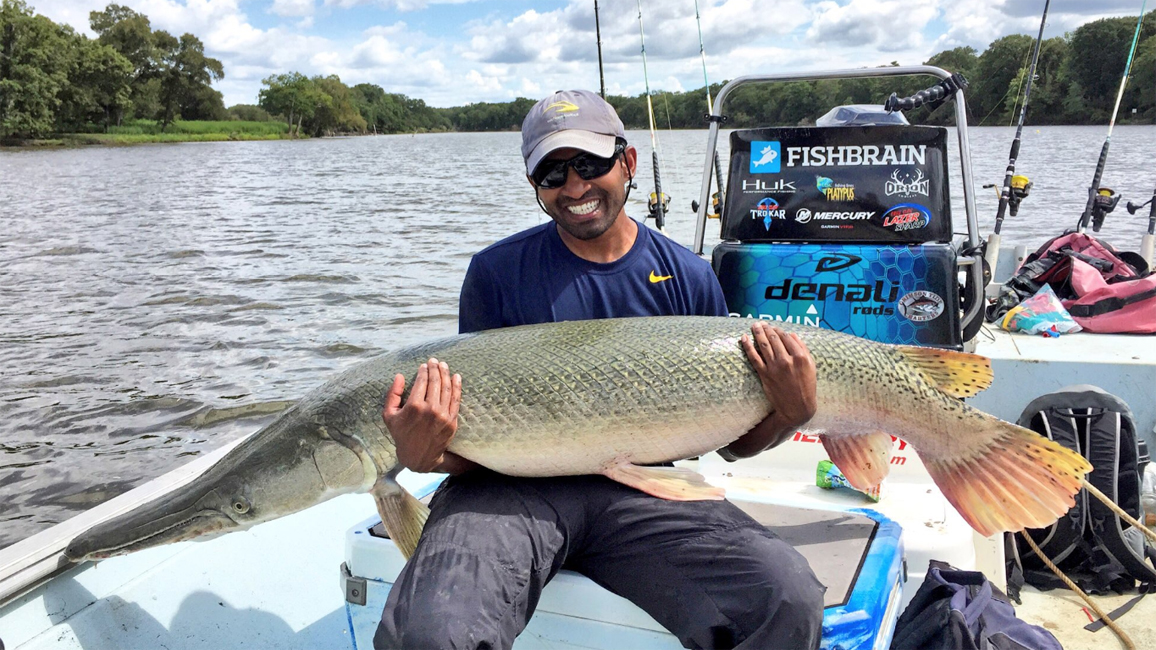
The Gar Guy
By Solomon DavidWhen I was 11 years old, I read a story about gars in Ranger Rick. I’ve been hooked on these awesome fishes ever since!

Imagine a big, scaly animal with long jaws and lots of teeth, swimming slowly in a lake. You might think it’s an alligator or crocodile. But when you look closely, you see that it has fins instead of legs and a tail like a paddle. You’re looking at a gar, a fish that has been around since dinosaur times!
As a fish scientist, I’ve studied gars for 20 years. And it all started when I got my first look at these amazing “dinosaur fishes” in Ranger Rick magazine!

SOMETHING FISHY
One look at a gar and you’ll see it’s not your typical fish. Gars have long, toothy snouts and tube-shaped bodies. They are covered with hard, diamond-shaped scales, which protect them like a suit of armor.
A gar’s sharp teeth might give it a frightening appearance, but these fish are harmless to people. If you’re a small fish, though, you might be in trouble. A gar likes to slowly swim up to an unsuspecting prey animal, then grab it with a quick sideswipe of its jaws. Although gars often eat fish, their menu can also include crayfish, reptiles, amphibians, and even small birds.
SIZE WISE
There are seven species of gars, and they live in lakes, swamps, and rivers in North and Central America (see map above). The smallest is the shortnose gar, which grows about as long as a yardstick. The largest is the alligator gar. It can grow to be longer than your sofa and weigh more than a giant panda!
LIVING FOSSILS
The gar family has been around for over 150 million years, existing way before T. rex lived. Gars have some special tricks that probably have helped them survive for so long. For one thing, gars can breathe air from the surface, storing it in a special lung-like body part. (Most fishes get their oxygen from water using gills.) This lets gars live in places where most other fishes can’t survive, such as really warm, sluggish waters, which are low in oxygen.
Here are a few other survival tricks: Though gar parents don’t provide any care for their young, baby gars are still protected. Their sticky eggs stay attached to underwater plants until they hatch. And though some eggs get eaten by fish, other predators had better leave those eggs alone—they’re poisonous to them! Scientists are trying to figure out what makes gar eggs poisonous.

PEOPLE PROBLEMS
Unfortunately, gars and people haven’t always gotten along. Some people who fish dislike gars. Gars can steal their bait and are hard to hook because of their bony heads. People sometimes catch and kill gars, then throw them back or simply leave them on the riverbank. They also used to think gars were eating the fish they wanted to catch. But scientists studying gars discovered that wasn’t necessarily true. And they learned that, like other predators, gars help keep balance in the ecosystem.
FUTURE HOPES
In some places, gars have disappeared. Dam construction and draining of wetlands for farms or building left them with no places to lay their eggs—or even survive.
Luckily, scientists are working to return gars to areas where they once lived. For example, they’re raising baby alligator gars in captivity and releasing them into the Mississippi River and other large rivers. Hopefully, those baby gars will someday grow to be giants like their parents!
Gars certainly are unique ancient fishes that I hope will be around for 150 million more years!
FISH STORY
The issue of Ranger Rick where I first learned about gars came out back in 1983. The prehistoric-looking fish was fascinating to me, like an underwater dinosaur. I wanted to learn more about gars and other animals, so I focused on science in school. I also got outside whenever I could, usually to explore nearby ponds and creeks. I went to college and then graduate school to study fish biology. Along the way, I learned that fish can tell us a lot about the health of our environment. Now I’m a fish scientist and professor at Nicholls State University in Louisiana. I’m glad I read that Ranger Rick “garticle” when I was young. I hope Ranger Rick can inspire you to learn more about nature, too!
















